Holly Thompson's Blog, page 37
July 5, 2011
A student's words on Fukushima
Teaching is tough some days. Not because of the marking and prep work, but because of the deep emotions and pain sometimes shared by students.
In some of my courses, teams of students lead discussions; they come up with a topic, prepare readings, and create pre-reading and discussion questions. One of today's discussions was on food safety in post 3/11 Japan. During these student-led discussions, I participate as if I were a student, and in my food safety group today, a student from Fukushima spoke up--poised, thoughtful, but clearly anguished. Here are her words:
"I'm from Fukushima. My grandfather is a farmer in western Fukushima. He grows rice and vegetables like eggplant, tomatoes and cucumbers.
"Of course I eat food from Fukushima. I eat my grandfather's food. I have to support people from Fukushima since I'm from Fukushima. But I'm suspicious. Is it really safe?
"People say Fukushima is dangerous. Did you hear him just now? [referring to a student across the room] He just said Fukushima is dangerous. Everyone thinks all of Fukushima is dangerous.
"Here's a true story: My aunt drove down to Chiba to shop and buy groceries at a supermarket about a week after the earthquake. When she came out of the supermarket she found Fukushima e kaere [go back to Fukushima!] written on the car window... and no cars parked nearby.
"My father's friend died in the tsunami. His wife is suffering from severe depression. There have been suicides.
"I want to know how this could happen. Nuclear power is not safe, but TEPCO told us, 'It's safe! It's safe!' Why did this happen?
"I want an explanation from the government. And most important, I want the government to be honest."
We listened. We asked her questions. She asked us questions. We shared our hopes for Fukushima and her grandfather.
And after class I sat in my office in aching silence.
In some of my courses, teams of students lead discussions; they come up with a topic, prepare readings, and create pre-reading and discussion questions. One of today's discussions was on food safety in post 3/11 Japan. During these student-led discussions, I participate as if I were a student, and in my food safety group today, a student from Fukushima spoke up--poised, thoughtful, but clearly anguished. Here are her words:
"I'm from Fukushima. My grandfather is a farmer in western Fukushima. He grows rice and vegetables like eggplant, tomatoes and cucumbers.
"Of course I eat food from Fukushima. I eat my grandfather's food. I have to support people from Fukushima since I'm from Fukushima. But I'm suspicious. Is it really safe?
"People say Fukushima is dangerous. Did you hear him just now? [referring to a student across the room] He just said Fukushima is dangerous. Everyone thinks all of Fukushima is dangerous.
"Here's a true story: My aunt drove down to Chiba to shop and buy groceries at a supermarket about a week after the earthquake. When she came out of the supermarket she found Fukushima e kaere [go back to Fukushima!] written on the car window... and no cars parked nearby.
"My father's friend died in the tsunami. His wife is suffering from severe depression. There have been suicides.
"I want to know how this could happen. Nuclear power is not safe, but TEPCO told us, 'It's safe! It's safe!' Why did this happen?
"I want an explanation from the government. And most important, I want the government to be honest."
We listened. We asked her questions. She asked us questions. We shared our hopes for Fukushima and her grandfather.
And after class I sat in my office in aching silence.
Published on July 05, 2011 07:56
July 3, 2011
Books for Tomorrow Project and other initiatives for Tohoku
On Saturday I went to Tokyo for the wonderful Charity Lectures: Writers Talk about the 3/11 Disaster and the Books for Tomorrow Project. The Books for Tomorrow Project (in Japanese あしたの本) is a joint initiative by the Japan Board on Books for Young People (JBBY), Japan P.E.N. Club, the Japan Publishers Club (JPC), and the Japan Publishing Foundation for Culture (JPIC). The mission of the Books for Tomorrow Project is to support children affected by the Great East Japan Earthquake and Tsunami through books. As stated on the JBBY website, "By working to put books in the hands of children, the Books for Tomorrow Project seeks to provide sources of comfort and enjoyment that will bolster their strength as they cope with the fears, anxieties, and uncertainties they face. The project involves a variety of activities centered on books and book-related programs."
The event was held at in Osaki at Gate City Osaki Hall along with the exhibit of children's book illustrations for the Books for Tomorrow Charity Auction. Before and after the event, participants wandered through the gallery area viewing the donated artwork, all still open to bidding online. There are so many great illustrations, including several donated by SCBWI Tokyo members.
 Viewing Akiko Hayashi's artwork showing the beloved Kon and Aki charactersThe talks were moderated by Akira Nogami, director of the Japan P.E.N. Club, and the first speaker was International Board on Books for Young People (IBBY) president, Ahmad Redza Ahmad Khairuddin, visiting Japan for a week and on his way up to Tohoku. He mentioned that the Books for Tomorrow Project exemplified the fact that often the best of people comes to the surface in bad times.
Viewing Akiko Hayashi's artwork showing the beloved Kon and Aki charactersThe talks were moderated by Akira Nogami, director of the Japan P.E.N. Club, and the first speaker was International Board on Books for Young People (IBBY) president, Ahmad Redza Ahmad Khairuddin, visiting Japan for a week and on his way up to Tohoku. He mentioned that the Books for Tomorrow Project exemplified the fact that often the best of people comes to the surface in bad times.
 IBBY president Ahmad Redza Ahmad Khairuddin with interpreterFollowing Ahmad Redza, Eiko Kadono, author of Majo no takkyubin (Kiki's Delivery Service) spoke of her experience reading to children in Tohoku. She also recalled her return to Tokyo a couple years after World War II and that on her arrival Akihabara the smell of burnt wood still permeated the air. She likened the landscapes of the tsunami-hit coasts of Tohoku to post-war Japan. She urged us each to take responsibility to help Japan forward.
IBBY president Ahmad Redza Ahmad Khairuddin with interpreterFollowing Ahmad Redza, Eiko Kadono, author of Majo no takkyubin (Kiki's Delivery Service) spoke of her experience reading to children in Tohoku. She also recalled her return to Tokyo a couple years after World War II and that on her arrival Akihabara the smell of burnt wood still permeated the air. She likened the landscapes of the tsunami-hit coasts of Tohoku to post-war Japan. She urged us each to take responsibility to help Japan forward.
Sachiko Kashiwaba, author of Dai obasan no fushigina reshipi (Great Aunt's Mysterious Recipes) and many other titles, spoke of the frightening night of 3/11 in Iwate, and their fear and worry for all the people on the coast. She spoke of meeting with teachers and the principal of a school in a tsunami-hit town, of listening to their harrowing tales of escape, and of the monumental challenge of helping children process their experiences when there are so few counselors in Tohoku. And she urged people to visit and support Iwate Prefecture.
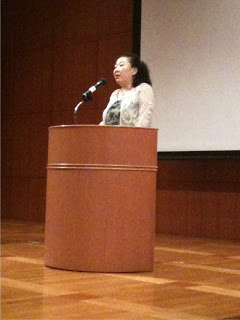 Author Sachiko KashiwabaAuthor Jun Saito spoke about the Ehon Project, begun by children's book editor and founder of Suemori Books, Chieko Suemori, and how the call for books led to mountains of books and that now the task lies in delivering them via their mobile libraries. Manga artist Machiko Satonaka talked of the desire to help through manga and the resulting Manga Japan group's charity auction (Japanese language). Atsuo Nakamura, actor and writer spoke of environmental issues, the destruction to the environment through nuclear power dependency, and the unfortunate manner in which the dangers have been hidden from people in Japan.
Author Sachiko KashiwabaAuthor Jun Saito spoke about the Ehon Project, begun by children's book editor and founder of Suemori Books, Chieko Suemori, and how the call for books led to mountains of books and that now the task lies in delivering them via their mobile libraries. Manga artist Machiko Satonaka talked of the desire to help through manga and the resulting Manga Japan group's charity auction (Japanese language). Atsuo Nakamura, actor and writer spoke of environmental issues, the destruction to the environment through nuclear power dependency, and the unfortunate manner in which the dangers have been hidden from people in Japan.
Wrapping up the event, novelist Eto Mori shared her struggle to discover what she could do to help. She recalled being asked to write pieces immediately after the earthquake, but she explained that authors are the people walking behind everyone else, the ones left pondering after everyone else has left the scene, and that she needed time to process the disaster. She went to Tohoku to volunteer but was discouraged that she didn't have more physical strength to offer to clean-up operations. She came to realize there were other ways she could help and decided to focus on rescuing pets from the affected areas.
After the talks, participants were invited to view the Books for Tomorrow mobile library (toshokan basu), which heads up to Tohoku later this month.
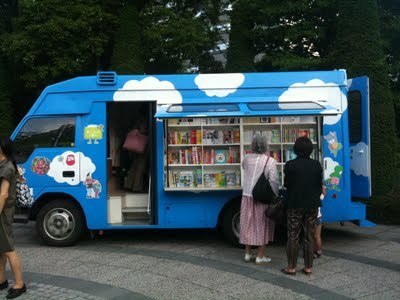 I chatted with Kiyoshi Nakaizumi of JPIC by the bus, decorated with fair-weather clouds and favorite children's book characters. He said that they would first take this mobile library to the hard-hit cities of Rikuzentakata, in Iwate Prefecture, and Kesennuma in Miyagi Prefecture.
I chatted with Kiyoshi Nakaizumi of JPIC by the bus, decorated with fair-weather clouds and favorite children's book characters. He said that they would first take this mobile library to the hard-hit cities of Rikuzentakata, in Iwate Prefecture, and Kesennuma in Miyagi Prefecture.
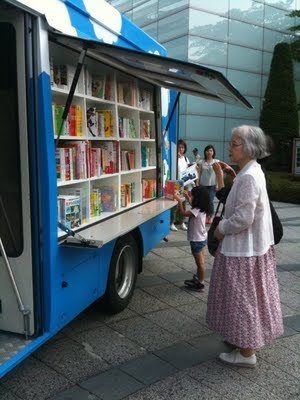 Author Eiko Kadono has a closer lookThe Books for Tomorrow Project welcomes donations. For those in Japan see JBBY's Books for Tomorrow Project bank transfer info and for those outside Japan see the IBBY Appeal for Japan page.
Author Eiko Kadono has a closer lookThe Books for Tomorrow Project welcomes donations. For those in Japan see JBBY's Books for Tomorrow Project bank transfer info and for those outside Japan see the IBBY Appeal for Japan page.
What an inspiring day full of creative, book-related messages of hope for Tohoku!
The event was held at in Osaki at Gate City Osaki Hall along with the exhibit of children's book illustrations for the Books for Tomorrow Charity Auction. Before and after the event, participants wandered through the gallery area viewing the donated artwork, all still open to bidding online. There are so many great illustrations, including several donated by SCBWI Tokyo members.
 Viewing Akiko Hayashi's artwork showing the beloved Kon and Aki charactersThe talks were moderated by Akira Nogami, director of the Japan P.E.N. Club, and the first speaker was International Board on Books for Young People (IBBY) president, Ahmad Redza Ahmad Khairuddin, visiting Japan for a week and on his way up to Tohoku. He mentioned that the Books for Tomorrow Project exemplified the fact that often the best of people comes to the surface in bad times.
Viewing Akiko Hayashi's artwork showing the beloved Kon and Aki charactersThe talks were moderated by Akira Nogami, director of the Japan P.E.N. Club, and the first speaker was International Board on Books for Young People (IBBY) president, Ahmad Redza Ahmad Khairuddin, visiting Japan for a week and on his way up to Tohoku. He mentioned that the Books for Tomorrow Project exemplified the fact that often the best of people comes to the surface in bad times. IBBY president Ahmad Redza Ahmad Khairuddin with interpreterFollowing Ahmad Redza, Eiko Kadono, author of Majo no takkyubin (Kiki's Delivery Service) spoke of her experience reading to children in Tohoku. She also recalled her return to Tokyo a couple years after World War II and that on her arrival Akihabara the smell of burnt wood still permeated the air. She likened the landscapes of the tsunami-hit coasts of Tohoku to post-war Japan. She urged us each to take responsibility to help Japan forward.
IBBY president Ahmad Redza Ahmad Khairuddin with interpreterFollowing Ahmad Redza, Eiko Kadono, author of Majo no takkyubin (Kiki's Delivery Service) spoke of her experience reading to children in Tohoku. She also recalled her return to Tokyo a couple years after World War II and that on her arrival Akihabara the smell of burnt wood still permeated the air. She likened the landscapes of the tsunami-hit coasts of Tohoku to post-war Japan. She urged us each to take responsibility to help Japan forward.Sachiko Kashiwaba, author of Dai obasan no fushigina reshipi (Great Aunt's Mysterious Recipes) and many other titles, spoke of the frightening night of 3/11 in Iwate, and their fear and worry for all the people on the coast. She spoke of meeting with teachers and the principal of a school in a tsunami-hit town, of listening to their harrowing tales of escape, and of the monumental challenge of helping children process their experiences when there are so few counselors in Tohoku. And she urged people to visit and support Iwate Prefecture.
 Author Sachiko KashiwabaAuthor Jun Saito spoke about the Ehon Project, begun by children's book editor and founder of Suemori Books, Chieko Suemori, and how the call for books led to mountains of books and that now the task lies in delivering them via their mobile libraries. Manga artist Machiko Satonaka talked of the desire to help through manga and the resulting Manga Japan group's charity auction (Japanese language). Atsuo Nakamura, actor and writer spoke of environmental issues, the destruction to the environment through nuclear power dependency, and the unfortunate manner in which the dangers have been hidden from people in Japan.
Author Sachiko KashiwabaAuthor Jun Saito spoke about the Ehon Project, begun by children's book editor and founder of Suemori Books, Chieko Suemori, and how the call for books led to mountains of books and that now the task lies in delivering them via their mobile libraries. Manga artist Machiko Satonaka talked of the desire to help through manga and the resulting Manga Japan group's charity auction (Japanese language). Atsuo Nakamura, actor and writer spoke of environmental issues, the destruction to the environment through nuclear power dependency, and the unfortunate manner in which the dangers have been hidden from people in Japan.Wrapping up the event, novelist Eto Mori shared her struggle to discover what she could do to help. She recalled being asked to write pieces immediately after the earthquake, but she explained that authors are the people walking behind everyone else, the ones left pondering after everyone else has left the scene, and that she needed time to process the disaster. She went to Tohoku to volunteer but was discouraged that she didn't have more physical strength to offer to clean-up operations. She came to realize there were other ways she could help and decided to focus on rescuing pets from the affected areas.
After the talks, participants were invited to view the Books for Tomorrow mobile library (toshokan basu), which heads up to Tohoku later this month.
 I chatted with Kiyoshi Nakaizumi of JPIC by the bus, decorated with fair-weather clouds and favorite children's book characters. He said that they would first take this mobile library to the hard-hit cities of Rikuzentakata, in Iwate Prefecture, and Kesennuma in Miyagi Prefecture.
I chatted with Kiyoshi Nakaizumi of JPIC by the bus, decorated with fair-weather clouds and favorite children's book characters. He said that they would first take this mobile library to the hard-hit cities of Rikuzentakata, in Iwate Prefecture, and Kesennuma in Miyagi Prefecture. Author Eiko Kadono has a closer lookThe Books for Tomorrow Project welcomes donations. For those in Japan see JBBY's Books for Tomorrow Project bank transfer info and for those outside Japan see the IBBY Appeal for Japan page.
Author Eiko Kadono has a closer lookThe Books for Tomorrow Project welcomes donations. For those in Japan see JBBY's Books for Tomorrow Project bank transfer info and for those outside Japan see the IBBY Appeal for Japan page.What an inspiring day full of creative, book-related messages of hope for Tohoku!
Published on July 03, 2011 16:00
July 1, 2011
Early Summer
I love this time of year in Kamakura.
Drums sound in the evenings as children of various neighborhood associations prepare for festivals.
Lanterns go up.
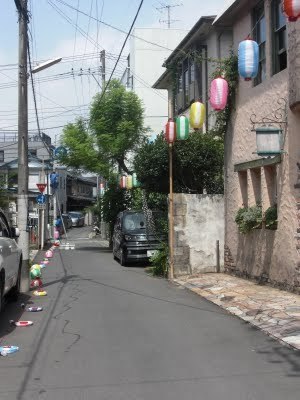
Dashi floats are rolled out.

Festivals begin.
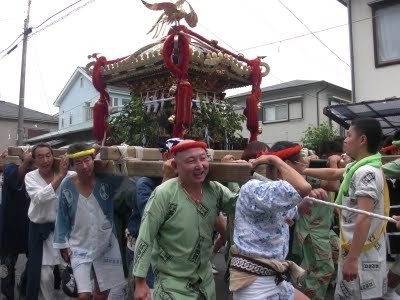

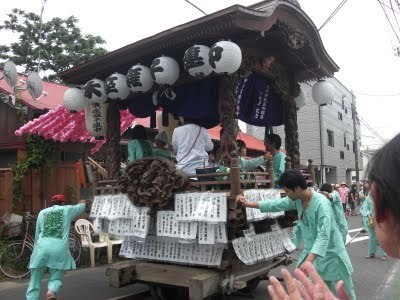
Tanabata decorations wave in the wind...
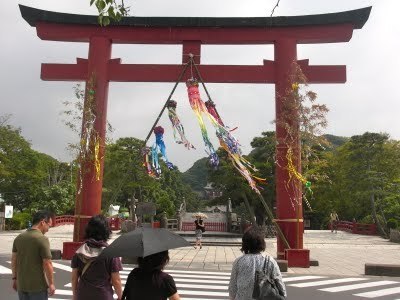
for the seventh day of the seventh month.
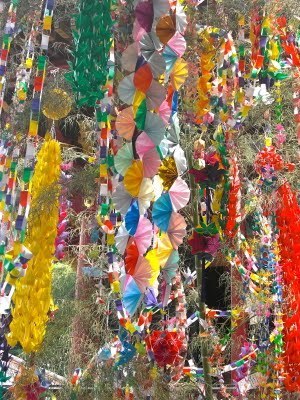
Lotus leaves fill ponds.
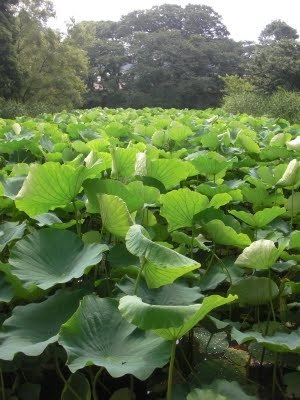 Buds rise from the water.
Buds rise from the water.

And the flowers are good.
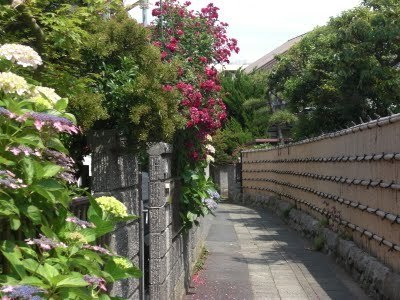

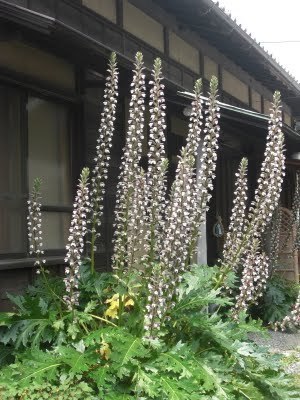 May some of this joy find its way north to Tohoku.
May some of this joy find its way north to Tohoku.
Drums sound in the evenings as children of various neighborhood associations prepare for festivals.
Lanterns go up.

Dashi floats are rolled out.

Festivals begin.



Tanabata decorations wave in the wind...

for the seventh day of the seventh month.

Lotus leaves fill ponds.
 Buds rise from the water.
Buds rise from the water.

And the flowers are good.


 May some of this joy find its way north to Tohoku.
May some of this joy find its way north to Tohoku.
Published on July 01, 2011 18:49
June 17, 2011
Announcing Tomo--A YA Anthology of Japan-Related Fiction
I am so happy to make this news official today! Tomo 友, an anthology of young adult fiction set in or related to Japan will be published in print and digital formats by Stone Bridge Press in Spring 2012. I will be the editor of this anthology, and the call for submissions is on my new Tomo blog. Please visit the Tomo blog for submission guidelines, sign on as a follower, and spread the news to writers with a connection to Japan by heritage or by experience. The submission deadline is August 15, 2011.

Tomo 友, which means friend in Japanese, is a benefit anthology to support teens affected by Great East Japan Earthquake of March 11, 2011. The publication of Tomo will coincide with the one-year anniversary of the earthquake and tsunami that devastated vast areas of northeastern Japan and resulted in loss of life and livelihood for thousands in northeastern Japan.
Why Tomo? As I explain on the Tomo blog, so many teens in Tohoku have lost parents, siblings, relatives, friends, homes, schools, and huge swaths of their cities, towns and villages. Their teen worlds have been upended. Many will suffer from post traumatic stress syndrome. Many will need financial support to complete their education.
Proceeds from the sales of the Tomo anthology will go to organizations that assist teens in the quake and tsunami hit areas. Tomo will link writers of young adult fiction with readers worldwide and the teens in Tohoku in need of their support.
Stone Bridge Press, with its focus on books related to Japan and Asia, is a perfect fit for this project. It is a pleasure to be working with the Stone Bridge team again.
The Tomo blog will feature news about the anthology, interviews with contributors, and information about the teens, locations and organizations that Tomo will support.
I am so excited about this new venture, to be in the editing role for a collection of Japan-related young adult fiction, and to be setting in motion a project that will benefit teens in the quake- and tsunami-affected areas who are coping with layer upon layer of loss. May their days ahead be full of promise... and friends from near and far.

Tomo 友, which means friend in Japanese, is a benefit anthology to support teens affected by Great East Japan Earthquake of March 11, 2011. The publication of Tomo will coincide with the one-year anniversary of the earthquake and tsunami that devastated vast areas of northeastern Japan and resulted in loss of life and livelihood for thousands in northeastern Japan.
Why Tomo? As I explain on the Tomo blog, so many teens in Tohoku have lost parents, siblings, relatives, friends, homes, schools, and huge swaths of their cities, towns and villages. Their teen worlds have been upended. Many will suffer from post traumatic stress syndrome. Many will need financial support to complete their education.
Proceeds from the sales of the Tomo anthology will go to organizations that assist teens in the quake and tsunami hit areas. Tomo will link writers of young adult fiction with readers worldwide and the teens in Tohoku in need of their support.
Stone Bridge Press, with its focus on books related to Japan and Asia, is a perfect fit for this project. It is a pleasure to be working with the Stone Bridge team again.
The Tomo blog will feature news about the anthology, interviews with contributors, and information about the teens, locations and organizations that Tomo will support.
I am so excited about this new venture, to be in the editing role for a collection of Japan-related young adult fiction, and to be setting in motion a project that will benefit teens in the quake- and tsunami-affected areas who are coping with layer upon layer of loss. May their days ahead be full of promise... and friends from near and far.
Published on June 17, 2011 23:48
June 2, 2011
Singapore's Asian Festival of Children's Content (AFCC)
I recently returned from a few days in Singapore where I attended the Asian Festival of Children's Content (AFCC). Like last year, the 2011 AFCC conference sessions were held at the 200-year-old Arts House, Singapore's first Parliament House, near Raffles' Landing Site, a riverside location in the midst everything.
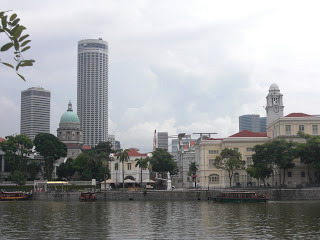 Boat Quay, Raffles' Landing Site
Boat Quay, Raffles' Landing Site
 the quay opposite the Arts House area
the quay opposite the Arts House area
 entrance to the Arts HouseOn the evening before the conference there was a kickoff panel presentation on the Kidlitosphere and YA Blogosphere with the amazing trio of Tarie Sabido (Asia in the Heart, World on the Mind, Into the Wardrobe and Color Online), Myra Garces-Bacsal (Gathering Books) and Corinne Robson (PaperTigers).
entrance to the Arts HouseOn the evening before the conference there was a kickoff panel presentation on the Kidlitosphere and YA Blogosphere with the amazing trio of Tarie Sabido (Asia in the Heart, World on the Mind, Into the Wardrobe and Color Online), Myra Garces-Bacsal (Gathering Books) and Corinne Robson (PaperTigers).
 Tarie Sabido, Myra Garces-Bacsal, Corinne RobsonSCBWI is one of the supporting organizations of AFCC, and president Stephen Mooser gave the opening keynote of the conference, somewhat dwarfed in the lofty parliament chamber.
Tarie Sabido, Myra Garces-Bacsal, Corinne RobsonSCBWI is one of the supporting organizations of AFCC, and president Stephen Mooser gave the opening keynote of the conference, somewhat dwarfed in the lofty parliament chamber.
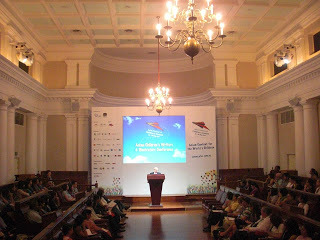 SCBWI President Stephen Mooser delivering the keynoteAFCC is the brainchild of Dr. R Ramachandran in particular, and the conference has developed rapidly over the past two year thanks to the hard work of many individuals.
SCBWI President Stephen Mooser delivering the keynoteAFCC is the brainchild of Dr. R Ramachandran in particular, and the conference has developed rapidly over the past two year thanks to the hard work of many individuals.
 Kenneth Quek, SCBWI Singapore Regional Advisor; Jade Yong, National Book Development Council of Singpore; R Ramachandran, AFCC Festival Director; Kathleen Ahrens, SCBWI International Regional Advisor ChairpersonAt AFCC, I gave two presentations, one on author/illustrator school visits, and the other on writing fiction for young adults, plus I moderated sessions by author Christopher Cheng, author/illustrator Yangsook Choi, and editor Neal Porter. Sessions for authors and illustrators were squeezed into two days this year, so I missed out on some great presentations I'd have liked to attend that were concurrent with mine or those I was moderating.
Kenneth Quek, SCBWI Singapore Regional Advisor; Jade Yong, National Book Development Council of Singpore; R Ramachandran, AFCC Festival Director; Kathleen Ahrens, SCBWI International Regional Advisor ChairpersonAt AFCC, I gave two presentations, one on author/illustrator school visits, and the other on writing fiction for young adults, plus I moderated sessions by author Christopher Cheng, author/illustrator Yangsook Choi, and editor Neal Porter. Sessions for authors and illustrators were squeezed into two days this year, so I missed out on some great presentations I'd have liked to attend that were concurrent with mine or those I was moderating.
There were First Look and First Pages panel critiques for both authors and illustrators.
 First Pages Panel Critiques with moderator Kathleen Ahrens, SCBWI International Regional Advisor Chairperson; Kelly Sonnack, Andrea Brown Literary Agency; Stephen Mooser, SCBWI President; Sayoni Basu, Scholastic IndiaChris Cheng presented on App and e-book development.
First Pages Panel Critiques with moderator Kathleen Ahrens, SCBWI International Regional Advisor Chairperson; Kelly Sonnack, Andrea Brown Literary Agency; Stephen Mooser, SCBWI President; Sayoni Basu, Scholastic IndiaChris Cheng presented on App and e-book development.
 Christopher Cheng on AppsDuring the conference, SCBWI members from around Asia and the Pacific gathered for a meeting and dinner...
Christopher Cheng on AppsDuring the conference, SCBWI members from around Asia and the Pacific gathered for a meeting and dinner...
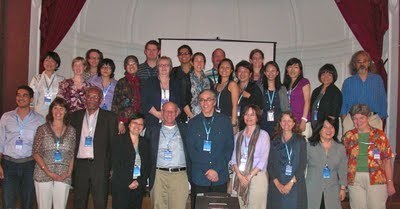 SCBWI members from Singapore, Hong Kong, Malaysia, Thailand, the Philippines, Japan, the U.S. Australia, and Canadaand it was great to meet members from some of the newer and rapidly growing SCBWI regions.
SCBWI members from Singapore, Hong Kong, Malaysia, Thailand, the Philippines, Japan, the U.S. Australia, and Canadaand it was great to meet members from some of the newer and rapidly growing SCBWI regions.
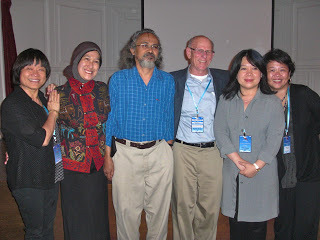 SCBWI Malaysia members with Stephen MooserThe President of the Democratic Republic of Timor Leste gave a special lecture and introduced Luis Soriano Bohorquez of Biblioburro, who started a traveling library with donkeys in Columbia. PaperTigers has a great blog post with video about his Biblioburro programs.
SCBWI Malaysia members with Stephen MooserThe President of the Democratic Republic of Timor Leste gave a special lecture and introduced Luis Soriano Bohorquez of Biblioburro, who started a traveling library with donkeys in Columbia. PaperTigers has a great blog post with video about his Biblioburro programs.
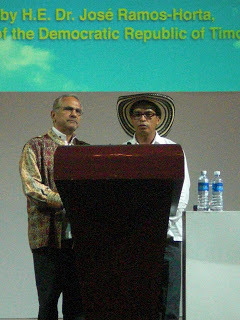 Dr. Jose Ramos-Horta and Luis Soriano BohorquezThree other SCBWI Tokyo members attended AFCC this year. See if you can spot them.
Dr. Jose Ramos-Horta and Luis Soriano BohorquezThree other SCBWI Tokyo members attended AFCC this year. See if you can spot them.
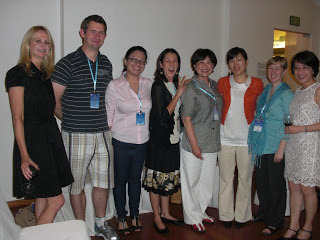 a few SCBWI Tokyo members with AFCC attendees from all overIn addition to the conference I squeezed in a couple international school visits where the students and librarians had created some great displays.
a few SCBWI Tokyo members with AFCC attendees from all overIn addition to the conference I squeezed in a couple international school visits where the students and librarians had created some great displays.
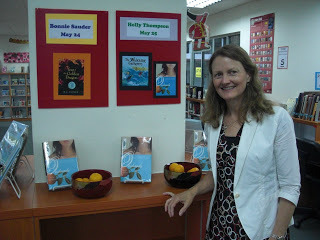 the librarian had even prepared bowls full of mikan
the librarian had even prepared bowls full of mikan
 for Japan
for Japan
 wakame and U.S.-Japan culture work
wakame and U.S.-Japan culture work
There was a wee bit of time to visit some older neighborhoods...
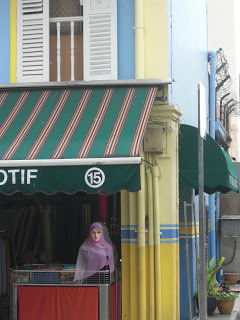 Kampong Glam/Arab District
Kampong Glam/Arab District
 Sultan Mosque
Sultan Mosque
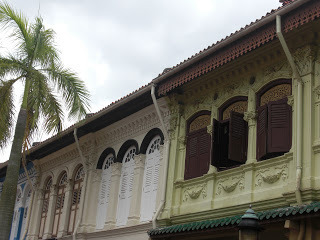 Kampong Glam/Arab Districtand to visit new neighborhoods...including Marina Bay Sands, approached from the Helix Bridge.
Kampong Glam/Arab Districtand to visit new neighborhoods...including Marina Bay Sands, approached from the Helix Bridge.
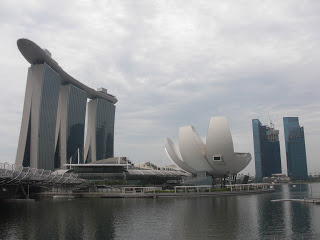 Marina Bay Sands and the lotus flower-like ArtsScience Museum
Marina Bay Sands and the lotus flower-like ArtsScience Museum
 Double Helix Bridge
Double Helix Bridge
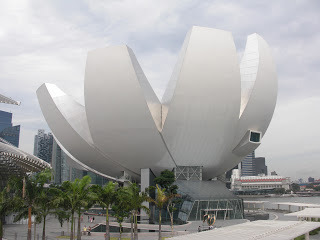 ArtScience MuseumOf course, I briefly checked out the infinity pool and Skypark, 57 stories high.
ArtScience MuseumOf course, I briefly checked out the infinity pool and Skypark, 57 stories high.
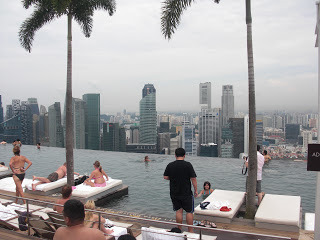
At the end of the day, I thoroughly appreciated the solar-powered, motion-sensor activated, strategically located cooling spots.
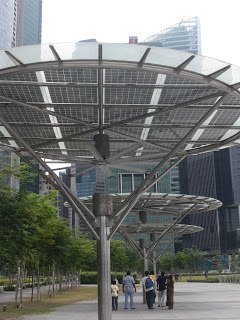 outdoor cooling fans And thanks to a friend's urging, I tried a Singapore street cart delicacy...
outdoor cooling fans And thanks to a friend's urging, I tried a Singapore street cart delicacy...
 can you guess?
can you guess?
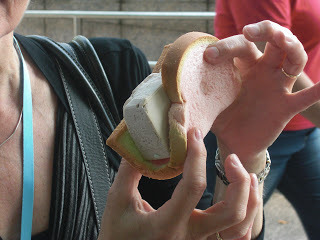 a block of ice cream in a folded slice of sweet breadSingapore was hot, some would say sweltering, every day--a nice change for me. The weather in Japan continues to be cool and rainy. But one of these days the sun will have to come out...right?
a block of ice cream in a folded slice of sweet breadSingapore was hot, some would say sweltering, every day--a nice change for me. The weather in Japan continues to be cool and rainy. But one of these days the sun will have to come out...right?
 Boat Quay, Raffles' Landing Site
Boat Quay, Raffles' Landing Site
 the quay opposite the Arts House area
the quay opposite the Arts House area
 entrance to the Arts HouseOn the evening before the conference there was a kickoff panel presentation on the Kidlitosphere and YA Blogosphere with the amazing trio of Tarie Sabido (Asia in the Heart, World on the Mind, Into the Wardrobe and Color Online), Myra Garces-Bacsal (Gathering Books) and Corinne Robson (PaperTigers).
entrance to the Arts HouseOn the evening before the conference there was a kickoff panel presentation on the Kidlitosphere and YA Blogosphere with the amazing trio of Tarie Sabido (Asia in the Heart, World on the Mind, Into the Wardrobe and Color Online), Myra Garces-Bacsal (Gathering Books) and Corinne Robson (PaperTigers).  Tarie Sabido, Myra Garces-Bacsal, Corinne RobsonSCBWI is one of the supporting organizations of AFCC, and president Stephen Mooser gave the opening keynote of the conference, somewhat dwarfed in the lofty parliament chamber.
Tarie Sabido, Myra Garces-Bacsal, Corinne RobsonSCBWI is one of the supporting organizations of AFCC, and president Stephen Mooser gave the opening keynote of the conference, somewhat dwarfed in the lofty parliament chamber. SCBWI President Stephen Mooser delivering the keynoteAFCC is the brainchild of Dr. R Ramachandran in particular, and the conference has developed rapidly over the past two year thanks to the hard work of many individuals.
SCBWI President Stephen Mooser delivering the keynoteAFCC is the brainchild of Dr. R Ramachandran in particular, and the conference has developed rapidly over the past two year thanks to the hard work of many individuals. Kenneth Quek, SCBWI Singapore Regional Advisor; Jade Yong, National Book Development Council of Singpore; R Ramachandran, AFCC Festival Director; Kathleen Ahrens, SCBWI International Regional Advisor ChairpersonAt AFCC, I gave two presentations, one on author/illustrator school visits, and the other on writing fiction for young adults, plus I moderated sessions by author Christopher Cheng, author/illustrator Yangsook Choi, and editor Neal Porter. Sessions for authors and illustrators were squeezed into two days this year, so I missed out on some great presentations I'd have liked to attend that were concurrent with mine or those I was moderating.
Kenneth Quek, SCBWI Singapore Regional Advisor; Jade Yong, National Book Development Council of Singpore; R Ramachandran, AFCC Festival Director; Kathleen Ahrens, SCBWI International Regional Advisor ChairpersonAt AFCC, I gave two presentations, one on author/illustrator school visits, and the other on writing fiction for young adults, plus I moderated sessions by author Christopher Cheng, author/illustrator Yangsook Choi, and editor Neal Porter. Sessions for authors and illustrators were squeezed into two days this year, so I missed out on some great presentations I'd have liked to attend that were concurrent with mine or those I was moderating.There were First Look and First Pages panel critiques for both authors and illustrators.
 First Pages Panel Critiques with moderator Kathleen Ahrens, SCBWI International Regional Advisor Chairperson; Kelly Sonnack, Andrea Brown Literary Agency; Stephen Mooser, SCBWI President; Sayoni Basu, Scholastic IndiaChris Cheng presented on App and e-book development.
First Pages Panel Critiques with moderator Kathleen Ahrens, SCBWI International Regional Advisor Chairperson; Kelly Sonnack, Andrea Brown Literary Agency; Stephen Mooser, SCBWI President; Sayoni Basu, Scholastic IndiaChris Cheng presented on App and e-book development. Christopher Cheng on AppsDuring the conference, SCBWI members from around Asia and the Pacific gathered for a meeting and dinner...
Christopher Cheng on AppsDuring the conference, SCBWI members from around Asia and the Pacific gathered for a meeting and dinner...  SCBWI members from Singapore, Hong Kong, Malaysia, Thailand, the Philippines, Japan, the U.S. Australia, and Canadaand it was great to meet members from some of the newer and rapidly growing SCBWI regions.
SCBWI members from Singapore, Hong Kong, Malaysia, Thailand, the Philippines, Japan, the U.S. Australia, and Canadaand it was great to meet members from some of the newer and rapidly growing SCBWI regions.  SCBWI Malaysia members with Stephen MooserThe President of the Democratic Republic of Timor Leste gave a special lecture and introduced Luis Soriano Bohorquez of Biblioburro, who started a traveling library with donkeys in Columbia. PaperTigers has a great blog post with video about his Biblioburro programs.
SCBWI Malaysia members with Stephen MooserThe President of the Democratic Republic of Timor Leste gave a special lecture and introduced Luis Soriano Bohorquez of Biblioburro, who started a traveling library with donkeys in Columbia. PaperTigers has a great blog post with video about his Biblioburro programs.  Dr. Jose Ramos-Horta and Luis Soriano BohorquezThree other SCBWI Tokyo members attended AFCC this year. See if you can spot them.
Dr. Jose Ramos-Horta and Luis Soriano BohorquezThree other SCBWI Tokyo members attended AFCC this year. See if you can spot them.  a few SCBWI Tokyo members with AFCC attendees from all overIn addition to the conference I squeezed in a couple international school visits where the students and librarians had created some great displays.
a few SCBWI Tokyo members with AFCC attendees from all overIn addition to the conference I squeezed in a couple international school visits where the students and librarians had created some great displays.  the librarian had even prepared bowls full of mikan
the librarian had even prepared bowls full of mikan for Japan
for Japan wakame and U.S.-Japan culture work
wakame and U.S.-Japan culture workThere was a wee bit of time to visit some older neighborhoods...
 Kampong Glam/Arab District
Kampong Glam/Arab District
 Sultan Mosque
Sultan Mosque
 Kampong Glam/Arab Districtand to visit new neighborhoods...including Marina Bay Sands, approached from the Helix Bridge.
Kampong Glam/Arab Districtand to visit new neighborhoods...including Marina Bay Sands, approached from the Helix Bridge. Marina Bay Sands and the lotus flower-like ArtsScience Museum
Marina Bay Sands and the lotus flower-like ArtsScience Museum
 Double Helix Bridge
Double Helix Bridge
 ArtScience MuseumOf course, I briefly checked out the infinity pool and Skypark, 57 stories high.
ArtScience MuseumOf course, I briefly checked out the infinity pool and Skypark, 57 stories high.
At the end of the day, I thoroughly appreciated the solar-powered, motion-sensor activated, strategically located cooling spots.
 outdoor cooling fans And thanks to a friend's urging, I tried a Singapore street cart delicacy...
outdoor cooling fans And thanks to a friend's urging, I tried a Singapore street cart delicacy... can you guess?
can you guess?
 a block of ice cream in a folded slice of sweet breadSingapore was hot, some would say sweltering, every day--a nice change for me. The weather in Japan continues to be cool and rainy. But one of these days the sun will have to come out...right?
a block of ice cream in a folded slice of sweet breadSingapore was hot, some would say sweltering, every day--a nice change for me. The weather in Japan continues to be cool and rainy. But one of these days the sun will have to come out...right?
Published on June 02, 2011 03:38
May 20, 2011
Mikan Blossoms
Opening my study window lately has brought me the faint scent of mikan blossoms--the neighbor has a single mikan tree in her yard. Catching that aroma has made me long for mikan orchards, so I made a brief day trip down to the Nishiura district of northwest Izu this week. I've been meaning to visit since Orchards was released...but almost nothing has gone as expected in Japan this spring.
In Nishiura, my husband and I dropped in on the farm family that I worked with for 18 months. It was like visiting relatives you have missed, and I was finally able to give them a copy of Orchards .
The generations have shifted in the few years since I worked there: the grandfather and grandmother have both passed away, and the eldest son now has two young children. It is reassuring to know that the three-generation household continues.
We sat and chatted at the house for over an hour, catching up on family news and recent happenings. We talked about tsunami escape routes, nuclear power, and how what used to seem safe is no longer really safe. How years ago in the villages the houses were all set farther back from the bay but that gradually they have been built closer and closer to the water for convenience.
Then we drove up in the truck to the terraced orchards and parked in the grove where I'd done my very first thinning work.
 the farmer with a copy of OrchardsAnd thanks to cool temperatures lately, flowering has been delayed, so that the mikan trees up at 160 meters are just now in full bloom. The fragrance wafts over the mountains and blows through the villages, a rich honey aroma like that of jasmine. I have so missed that scent, and in the groves I gulped lungs full of the sweet air.
the farmer with a copy of OrchardsAnd thanks to cool temperatures lately, flowering has been delayed, so that the mikan trees up at 160 meters are just now in full bloom. The fragrance wafts over the mountains and blows through the villages, a rich honey aroma like that of jasmine. I have so missed that scent, and in the groves I gulped lungs full of the sweet air.
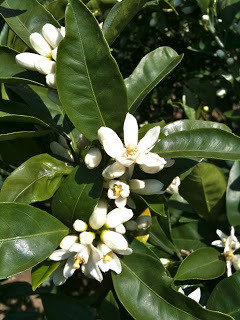 mikan (Citrus unshu) blossomsWe looked closely at the flowers on the trees and tasted the nectar surrounding the tiny peppercorn-sized mikan inside.
mikan (Citrus unshu) blossomsWe looked closely at the flowers on the trees and tasted the nectar surrounding the tiny peppercorn-sized mikan inside.
 examining the flowers We talked about mold concerns. About how there haven't been enough bees this year. How the deer are becoming real pests, and that they will even eat ears of rice. How shinryoku (new green leaves) in the hills is even prettier than fall foliage. I was so glad to be back in the groves immersed in farm talk among the rows of trees, and I breathed in the heady scent of mikan blossom until I was nearly hyperventilating.
examining the flowers We talked about mold concerns. About how there haven't been enough bees this year. How the deer are becoming real pests, and that they will even eat ears of rice. How shinryoku (new green leaves) in the hills is even prettier than fall foliage. I was so glad to be back in the groves immersed in farm talk among the rows of trees, and I breathed in the heady scent of mikan blossom until I was nearly hyperventilating.
Eventually the farmer said, "Do you want to take some home?" and he cut two branches for me.
 among the mikan trees with hills in new greenWhen we left village, the farmer and his wife gave us a bag of large natsu mikan (summer mikan, Citrus natsudaidai) and cans of jutaro mikan, the district's famous variety.
among the mikan trees with hills in new greenWhen we left village, the farmer and his wife gave us a bag of large natsu mikan (summer mikan, Citrus natsudaidai) and cans of jutaro mikan, the district's famous variety.
Before leaving the area we had a lunch at the farmer's cousin's restaurant Irie, 井里絵.
 aji (horse mackerel) rice bowl lunchWe also stopped at the district hall to donate a copy of Orchards to the district library. Then we took a brief hike in the Darumayama area...
aji (horse mackerel) rice bowl lunchWe also stopped at the district hall to donate a copy of Orchards to the district library. Then we took a brief hike in the Darumayama area...
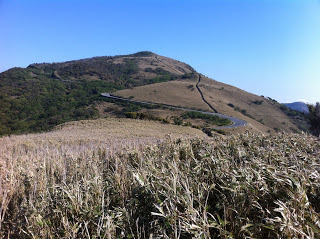 and enjoyed a quick hotspring bath in Shuzenji. Perfect.
and enjoyed a quick hotspring bath in Shuzenji. Perfect.
All the way back to Kamakura in the car I breathed in mikan bloom. At home I set the branches in a vase. Now the breeze blows through the open windows. If I close my eyes, block my ears, I can imagine I'm back in the mikan groves.
 cans of Jutaro mikan, branches of unshu mikan, plate of large natsu mikan
cans of Jutaro mikan, branches of unshu mikan, plate of large natsu mikan
In Nishiura, my husband and I dropped in on the farm family that I worked with for 18 months. It was like visiting relatives you have missed, and I was finally able to give them a copy of Orchards .
The generations have shifted in the few years since I worked there: the grandfather and grandmother have both passed away, and the eldest son now has two young children. It is reassuring to know that the three-generation household continues.
We sat and chatted at the house for over an hour, catching up on family news and recent happenings. We talked about tsunami escape routes, nuclear power, and how what used to seem safe is no longer really safe. How years ago in the villages the houses were all set farther back from the bay but that gradually they have been built closer and closer to the water for convenience.
Then we drove up in the truck to the terraced orchards and parked in the grove where I'd done my very first thinning work.
 the farmer with a copy of OrchardsAnd thanks to cool temperatures lately, flowering has been delayed, so that the mikan trees up at 160 meters are just now in full bloom. The fragrance wafts over the mountains and blows through the villages, a rich honey aroma like that of jasmine. I have so missed that scent, and in the groves I gulped lungs full of the sweet air.
the farmer with a copy of OrchardsAnd thanks to cool temperatures lately, flowering has been delayed, so that the mikan trees up at 160 meters are just now in full bloom. The fragrance wafts over the mountains and blows through the villages, a rich honey aroma like that of jasmine. I have so missed that scent, and in the groves I gulped lungs full of the sweet air. mikan (Citrus unshu) blossomsWe looked closely at the flowers on the trees and tasted the nectar surrounding the tiny peppercorn-sized mikan inside.
mikan (Citrus unshu) blossomsWe looked closely at the flowers on the trees and tasted the nectar surrounding the tiny peppercorn-sized mikan inside. examining the flowers We talked about mold concerns. About how there haven't been enough bees this year. How the deer are becoming real pests, and that they will even eat ears of rice. How shinryoku (new green leaves) in the hills is even prettier than fall foliage. I was so glad to be back in the groves immersed in farm talk among the rows of trees, and I breathed in the heady scent of mikan blossom until I was nearly hyperventilating.
examining the flowers We talked about mold concerns. About how there haven't been enough bees this year. How the deer are becoming real pests, and that they will even eat ears of rice. How shinryoku (new green leaves) in the hills is even prettier than fall foliage. I was so glad to be back in the groves immersed in farm talk among the rows of trees, and I breathed in the heady scent of mikan blossom until I was nearly hyperventilating.Eventually the farmer said, "Do you want to take some home?" and he cut two branches for me.
 among the mikan trees with hills in new greenWhen we left village, the farmer and his wife gave us a bag of large natsu mikan (summer mikan, Citrus natsudaidai) and cans of jutaro mikan, the district's famous variety.
among the mikan trees with hills in new greenWhen we left village, the farmer and his wife gave us a bag of large natsu mikan (summer mikan, Citrus natsudaidai) and cans of jutaro mikan, the district's famous variety. Before leaving the area we had a lunch at the farmer's cousin's restaurant Irie, 井里絵.
 aji (horse mackerel) rice bowl lunchWe also stopped at the district hall to donate a copy of Orchards to the district library. Then we took a brief hike in the Darumayama area...
aji (horse mackerel) rice bowl lunchWe also stopped at the district hall to donate a copy of Orchards to the district library. Then we took a brief hike in the Darumayama area... and enjoyed a quick hotspring bath in Shuzenji. Perfect.
and enjoyed a quick hotspring bath in Shuzenji. Perfect.All the way back to Kamakura in the car I breathed in mikan bloom. At home I set the branches in a vase. Now the breeze blows through the open windows. If I close my eyes, block my ears, I can imagine I'm back in the mikan groves.
 cans of Jutaro mikan, branches of unshu mikan, plate of large natsu mikan
cans of Jutaro mikan, branches of unshu mikan, plate of large natsu mikan
Published on May 20, 2011 08:06
May 18, 2011
If you're thinking of volunteering in Tohoku...A Packing List
As an epilogue to my week of posts about my week in Tohoku volunteering with the NGO Peace Boat in the tsunami-devastated city of Ishinomaki, Miyagi Prefecture, I would like to offer a few practical suggestions for those who plan to volunteer. Packing for a relief trip is a bit different from packing for most ordinary camping trips. Camping in a disaster area means camping with a limited water supply, and there's little water for cleaning dishes, cooking, and washing yourself. Camping in a relief area also requires some extra precautions in that volunteers need to be prepared with enough food, water, means of communication, clothing, etc. should an aftershock disrupt services further.
At the Peace Boat orientation sessions offered on Saturday evenings in Tokyo, participants receive packing lists and information about the volunteer work. Below is a list that includes Peace Boat suggestions mixed in with those of my team. The list of items is long and may seem like a lot of stuff to pull together, but keep in mind that most of these items are good to have on hand anyway in an earthquake-prone country like Japan.
camping gear
tent with tent fly, stakes, poles
ground sheet/tarp for under tent
sleeping mat
sleeping bag
cook stove for camping
gas for cook stove
windscreen for cook stove
mess kit--pans/dishes/cup
utensils for cooking and eating
matches/lighter
headlamp, LED, for use at campsite/going to toilet at night
small LED lantern with batteries for inside tent
tiny, folding camp stool if you have one
plastic sheet (to sit on or for boots, etc.)
padlocks for tent doors
clips, S hooks, rubber bands
clothes and gear for volunteer work
helmet if you have one (if not, Peace Boat has these)
waterproof suit--lightweight, breathable
safety boots (anzen nagagutsu)
metal insoles for your boots if you can find them
socks that fit well with your boots
full roll of gum tape for taping boots to pants
(so water/debris can't enter boots)
headlamp, LED
(a second one that you can keep taped to your helmet is nice)
safety goggles
masks--the types worn by construction workers
leather gloves
latex rubber gloves for inside leather gloves
(keep hands dry, warm, protected)
rugged rubber gloves with long arms for wet work
towels--onsen size, for neck to keep out dust, for drying off
wet wipes/hand sanitizer
tissues (toilets at work sites might not have paper)
bandanas/tenugui for wrapping head
(keeps hair/head clean, helps helmet fit)
T-shirts--dry-type for wicking sweat
lightweight warm layer to add in the morning/at end of work day
water bottles
day pack to hold lunch, water, camera, different gloves, wipes, etc.
Swiss Army knife/Leatherman multi-tool is helpful
camping clothes
underwear, socks
lightweight, warm top layers
jeans
slip-on rugged shoes or sneakers
sleepwear/leggings/hooded sweatshirt
jacket for cold evenings
hat for cold evenings
thin gloves for cold evenings
food and water
4-6 liters of water
(Peace Boat provides a water truck for refilling water bottles)
funnel for filling water bottles from water truck hose
granola bars, soy joy, calorie mate
nuts
dried fruit
muesli or granola
powdered milk
onigiri for the first few days
hearty bread or stay-fresh Delba bread
peanut butter
salami
dried fish
instant noodles (especially the eco pack cup noodles)
small canned items like beans or tuna
dried vegetables (good with noodles)
curry in single-serving retort pouches (good with noodles)
instant miso soup and fixings of dried wakame, tofu, etc.
other instant meals, MREs, zosui in retort pouches
chocolate
sweets to share
tea/herb tea/instant coffee/cocoa
zip-close bags
plastic wrap (to set inside dishes for waterless clean up)
other items
hand sanitizer
body wipes
facial wipes
small tissue packs
no-water alcohol shampoo
toiletries including nail clippers, cotton swabs, eye drops, lotion,
sunscreen, some shampoo
basic first aid items--antibiotic ointment, bandages, fever reducer, etc.
hot water bottle--small (for inside sleeping bag on cold nights)
adhesive body warmers (for cold nights)
inflatable pillow (for overnight bus and tent)
camera (and extra battery if necessary)
radio--small, battery operated, in case of emergency, news
cell phone (there was reception in all areas our team visited)
cell phone charger--battery or solar power
(try to find a charger not just an emergency battery)
extra batteries for everything
laundry hanging apparatus, small--for drying gloves, towels, socks
extra trash bags--to keep things dry, to separate smelly clothes, etc.
folding umbrellapens and permanent marker for labeling
small notebook and journal
money for bus, small purchases, and in case of emergency
health insurance card
foreign registration card/copy of passport
Japanese driver's license if you have one
phone numbers for emergency contact
(in case of cell phone service disruption)
Luggage
large backpack (or suitcase)
daypack to take to worksite
small bag
folding luggage cart for easy lugging of tent, etc.
Here are a few photos that may be helpful:
 clockwise from top left: tenugui, work masks, safety goggles
clockwise from top left: tenugui, work masks, safety goggles
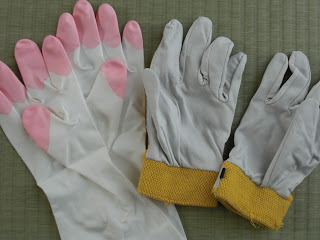 latex gloves and leather gloves
latex gloves and leather gloves
 clockwise from top left: cook stove, wind screen, mess kit, untensils, Leatherman multi-tool
clockwise from top left: cook stove, wind screen, mess kit, untensils, Leatherman multi-tool
 clockwise from top left: adhesive body warmers, LED headlamp, small lantern, camp stool, drying apparatus, small hot-water bottle
clockwise from top left: adhesive body warmers, LED headlamp, small lantern, camp stool, drying apparatus, small hot-water bottle
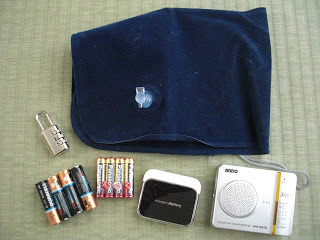 clockwise from top left: combination padlock, inflatable pillow, radio, emergency cell phone battery, batteries
clockwise from top left: combination padlock, inflatable pillow, radio, emergency cell phone battery, batteries
Wishing you a safe and fulfilling volunteer experience!
At the Peace Boat orientation sessions offered on Saturday evenings in Tokyo, participants receive packing lists and information about the volunteer work. Below is a list that includes Peace Boat suggestions mixed in with those of my team. The list of items is long and may seem like a lot of stuff to pull together, but keep in mind that most of these items are good to have on hand anyway in an earthquake-prone country like Japan.
camping gear
tent with tent fly, stakes, poles
ground sheet/tarp for under tent
sleeping mat
sleeping bag
cook stove for camping
gas for cook stove
windscreen for cook stove
mess kit--pans/dishes/cup
utensils for cooking and eating
matches/lighter
headlamp, LED, for use at campsite/going to toilet at night
small LED lantern with batteries for inside tent
tiny, folding camp stool if you have one
plastic sheet (to sit on or for boots, etc.)
padlocks for tent doors
clips, S hooks, rubber bands
clothes and gear for volunteer work
helmet if you have one (if not, Peace Boat has these)
waterproof suit--lightweight, breathable
safety boots (anzen nagagutsu)
metal insoles for your boots if you can find them
socks that fit well with your boots
full roll of gum tape for taping boots to pants
(so water/debris can't enter boots)
headlamp, LED
(a second one that you can keep taped to your helmet is nice)
safety goggles
masks--the types worn by construction workers
leather gloves
latex rubber gloves for inside leather gloves
(keep hands dry, warm, protected)
rugged rubber gloves with long arms for wet work
towels--onsen size, for neck to keep out dust, for drying off
wet wipes/hand sanitizer
tissues (toilets at work sites might not have paper)
bandanas/tenugui for wrapping head
(keeps hair/head clean, helps helmet fit)
T-shirts--dry-type for wicking sweat
lightweight warm layer to add in the morning/at end of work day
water bottles
day pack to hold lunch, water, camera, different gloves, wipes, etc.
Swiss Army knife/Leatherman multi-tool is helpful
camping clothes
underwear, socks
lightweight, warm top layers
jeans
slip-on rugged shoes or sneakers
sleepwear/leggings/hooded sweatshirt
jacket for cold evenings
hat for cold evenings
thin gloves for cold evenings
food and water
4-6 liters of water
(Peace Boat provides a water truck for refilling water bottles)
funnel for filling water bottles from water truck hose
granola bars, soy joy, calorie mate
nuts
dried fruit
muesli or granola
powdered milk
onigiri for the first few days
hearty bread or stay-fresh Delba bread
peanut butter
salami
dried fish
instant noodles (especially the eco pack cup noodles)
small canned items like beans or tuna
dried vegetables (good with noodles)
curry in single-serving retort pouches (good with noodles)
instant miso soup and fixings of dried wakame, tofu, etc.
other instant meals, MREs, zosui in retort pouches
chocolate
sweets to share
tea/herb tea/instant coffee/cocoa
zip-close bags
plastic wrap (to set inside dishes for waterless clean up)
other items
hand sanitizer
body wipes
facial wipes
small tissue packs
no-water alcohol shampoo
toiletries including nail clippers, cotton swabs, eye drops, lotion,
sunscreen, some shampoo
basic first aid items--antibiotic ointment, bandages, fever reducer, etc.
hot water bottle--small (for inside sleeping bag on cold nights)
adhesive body warmers (for cold nights)
inflatable pillow (for overnight bus and tent)
camera (and extra battery if necessary)
radio--small, battery operated, in case of emergency, news
cell phone (there was reception in all areas our team visited)
cell phone charger--battery or solar power
(try to find a charger not just an emergency battery)
extra batteries for everything
laundry hanging apparatus, small--for drying gloves, towels, socks
extra trash bags--to keep things dry, to separate smelly clothes, etc.
folding umbrellapens and permanent marker for labeling
small notebook and journal
money for bus, small purchases, and in case of emergency
health insurance card
foreign registration card/copy of passport
Japanese driver's license if you have one
phone numbers for emergency contact
(in case of cell phone service disruption)
Luggage
large backpack (or suitcase)
daypack to take to worksite
small bag
folding luggage cart for easy lugging of tent, etc.
Here are a few photos that may be helpful:
 clockwise from top left: tenugui, work masks, safety goggles
clockwise from top left: tenugui, work masks, safety goggles
 latex gloves and leather gloves
latex gloves and leather gloves
 clockwise from top left: cook stove, wind screen, mess kit, untensils, Leatherman multi-tool
clockwise from top left: cook stove, wind screen, mess kit, untensils, Leatherman multi-tool
 clockwise from top left: adhesive body warmers, LED headlamp, small lantern, camp stool, drying apparatus, small hot-water bottle
clockwise from top left: adhesive body warmers, LED headlamp, small lantern, camp stool, drying apparatus, small hot-water bottle
 clockwise from top left: combination padlock, inflatable pillow, radio, emergency cell phone battery, batteries
clockwise from top left: combination padlock, inflatable pillow, radio, emergency cell phone battery, batteriesWishing you a safe and fulfilling volunteer experience!
Published on May 18, 2011 06:00
May 17, 2011
Ishinomaki Day 8
Following is Day 8 of my week in Tohoku volunteering with the NGO Peace Boat in the tsunami-devastated city of Ishinomaki, Miyagi Prefecture.
I rose at 4:45 when the rattle of pots and pans from others in the campsite woke me up. It was a damp, foggy morning. After a quick breakfast, like everyone else I began the task of packing up.
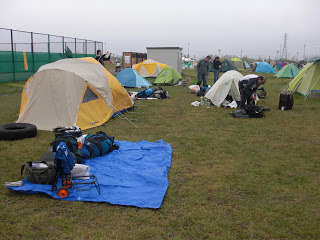 packing upWe had to have our tents down and belongings off the site and into a storage area by morning meeting at 7:30.
packing upWe had to have our tents down and belongings off the site and into a storage area by morning meeting at 7:30.
 by 5:50 many tents are already downMy tent pole repair had held up...barely.
by 5:50 many tents are already downMy tent pole repair had held up...barely.
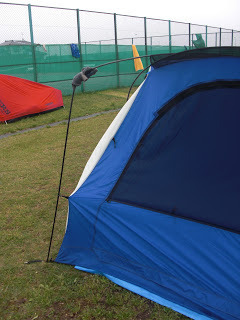 tape, PVC pipe, a sock...We packed everything up and placed our bags and gear in a container area.
tape, PVC pipe, a sock...We packed everything up and placed our bags and gear in a container area.
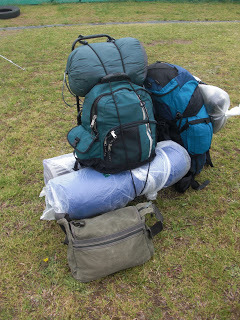 slightly lighter loadWe attended our last morning meeting and performed our last rajio taiso exercises. One international volunteer led a team shout as a closing to the week and to celebrate the productive team spirit. We gave a huge round of applause to Peace Boat staff for an incredibly well-run week, and they urged us to come back soon.
slightly lighter loadWe attended our last morning meeting and performed our last rajio taiso exercises. One international volunteer led a team shout as a closing to the week and to celebrate the productive team spirit. We gave a huge round of applause to Peace Boat staff for an incredibly well-run week, and they urged us to come back soon.
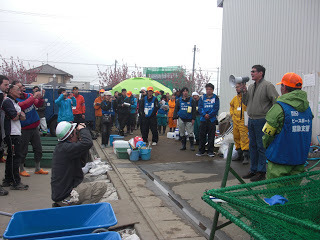 last morning meeting...team shout outWe were given some simple campsite assignments to complete over a leisurely two hours. Some teams volunteered for toilet cleaning.
last morning meeting...team shout outWe were given some simple campsite assignments to complete over a leisurely two hours. Some teams volunteered for toilet cleaning.
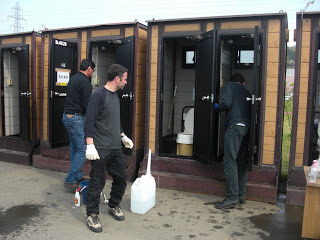 toilet cleaning detail Our team picked up litter around the campus.
toilet cleaning detail Our team picked up litter around the campus.
 easy litter detail...behind us are the tents of volunteers staying onAnd we enjoyed the cherry blossoms.
easy litter detail...behind us are the tents of volunteers staying onAnd we enjoyed the cherry blossoms.
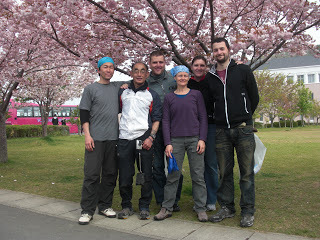 team 57
team 57
Even Mr. Wada's showers were being dismantled.
 hot-water showersThe water truck arrived for the day as usual.
hot-water showersThe water truck arrived for the day as usual.
 drinking water for volunteersPeace Boat staff members were busy in the supply warehouse...
drinking water for volunteersPeace Boat staff members were busy in the supply warehouse...
 Peace Boat supply warehouse for relief goods, equipment and welcoming the new batch of volunteers.
Peace Boat supply warehouse for relief goods, equipment and welcoming the new batch of volunteers.
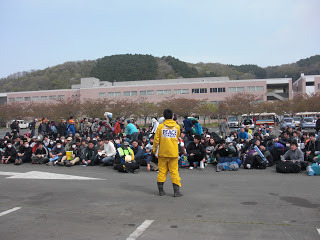 the new set of volunteers The new recruits were fewer in number and many of us Golden Week volunteers wished we could have stayed another week.
the new set of volunteers The new recruits were fewer in number and many of us Golden Week volunteers wished we could have stayed another week.
Soon we were loading our gear onto the buses.
 boarding the busesAnd all too quickly, it seemed, we were on our way back to Tokyo.
boarding the busesAnd all too quickly, it seemed, we were on our way back to Tokyo.
 yes, those are chandeliers in our busI know that many of us who volunteered with Peace Boat during Golden Week will return to help again. The experience of working as teams, meeting volunteers from all over Japan and the world, working directly with very appreciative locals, and seeing progress day by day was life changing. We are keenly aware that many hands make, if not light work, lighter work, and that continued help and support is desperately needed in Ishinomaki, and in the many cities and small towns up and down the coast of Tohoku.
yes, those are chandeliers in our busI know that many of us who volunteered with Peace Boat during Golden Week will return to help again. The experience of working as teams, meeting volunteers from all over Japan and the world, working directly with very appreciative locals, and seeing progress day by day was life changing. We are keenly aware that many hands make, if not light work, lighter work, and that continued help and support is desperately needed in Ishinomaki, and in the many cities and small towns up and down the coast of Tohoku.
If you are able-bodied, live in or can visit Japan, please consider volunteering with Peace Boat. Tohoku definitely needs your help.
I rose at 4:45 when the rattle of pots and pans from others in the campsite woke me up. It was a damp, foggy morning. After a quick breakfast, like everyone else I began the task of packing up.
 packing upWe had to have our tents down and belongings off the site and into a storage area by morning meeting at 7:30.
packing upWe had to have our tents down and belongings off the site and into a storage area by morning meeting at 7:30. by 5:50 many tents are already downMy tent pole repair had held up...barely.
by 5:50 many tents are already downMy tent pole repair had held up...barely. tape, PVC pipe, a sock...We packed everything up and placed our bags and gear in a container area.
tape, PVC pipe, a sock...We packed everything up and placed our bags and gear in a container area. slightly lighter loadWe attended our last morning meeting and performed our last rajio taiso exercises. One international volunteer led a team shout as a closing to the week and to celebrate the productive team spirit. We gave a huge round of applause to Peace Boat staff for an incredibly well-run week, and they urged us to come back soon.
slightly lighter loadWe attended our last morning meeting and performed our last rajio taiso exercises. One international volunteer led a team shout as a closing to the week and to celebrate the productive team spirit. We gave a huge round of applause to Peace Boat staff for an incredibly well-run week, and they urged us to come back soon. last morning meeting...team shout outWe were given some simple campsite assignments to complete over a leisurely two hours. Some teams volunteered for toilet cleaning.
last morning meeting...team shout outWe were given some simple campsite assignments to complete over a leisurely two hours. Some teams volunteered for toilet cleaning. toilet cleaning detail Our team picked up litter around the campus.
toilet cleaning detail Our team picked up litter around the campus.  easy litter detail...behind us are the tents of volunteers staying onAnd we enjoyed the cherry blossoms.
easy litter detail...behind us are the tents of volunteers staying onAnd we enjoyed the cherry blossoms. team 57
team 57Even Mr. Wada's showers were being dismantled.
 hot-water showersThe water truck arrived for the day as usual.
hot-water showersThe water truck arrived for the day as usual. drinking water for volunteersPeace Boat staff members were busy in the supply warehouse...
drinking water for volunteersPeace Boat staff members were busy in the supply warehouse... Peace Boat supply warehouse for relief goods, equipment and welcoming the new batch of volunteers.
Peace Boat supply warehouse for relief goods, equipment and welcoming the new batch of volunteers. the new set of volunteers The new recruits were fewer in number and many of us Golden Week volunteers wished we could have stayed another week.
the new set of volunteers The new recruits were fewer in number and many of us Golden Week volunteers wished we could have stayed another week. Soon we were loading our gear onto the buses.
 boarding the busesAnd all too quickly, it seemed, we were on our way back to Tokyo.
boarding the busesAnd all too quickly, it seemed, we were on our way back to Tokyo. yes, those are chandeliers in our busI know that many of us who volunteered with Peace Boat during Golden Week will return to help again. The experience of working as teams, meeting volunteers from all over Japan and the world, working directly with very appreciative locals, and seeing progress day by day was life changing. We are keenly aware that many hands make, if not light work, lighter work, and that continued help and support is desperately needed in Ishinomaki, and in the many cities and small towns up and down the coast of Tohoku.
yes, those are chandeliers in our busI know that many of us who volunteered with Peace Boat during Golden Week will return to help again. The experience of working as teams, meeting volunteers from all over Japan and the world, working directly with very appreciative locals, and seeing progress day by day was life changing. We are keenly aware that many hands make, if not light work, lighter work, and that continued help and support is desperately needed in Ishinomaki, and in the many cities and small towns up and down the coast of Tohoku.If you are able-bodied, live in or can visit Japan, please consider volunteering with Peace Boat. Tohoku definitely needs your help.
Published on May 17, 2011 01:58
May 15, 2011
Ishinomaki Day 7
Following is Day 7 of my week in Tohoku volunteering with the NGO Peace Boat in the tsunami-devastated city of Ishinomaki, Miyagi Prefecture.
There was another rumble in the middle of the night--I noted it and went promptly back to sleep. Fog and clouds had rolled in overnight and were slow to lift from the hills. At the morning meeting after our exercises, three volunteers, two of them New Zealanders, performed a haka...to give us courage to do battle against the tsunami damage.
Our team was assigned to ride bicycles into town. We'd been waiting for our turn day after day, so this was welcomed news. It was so nice be in the open air as we crossed the bridge that spanned the river and rice fields with the hills in the distance in all shades of new green. After crossing the river as we approached the center of the city it was a matter of weaving in and out debris.
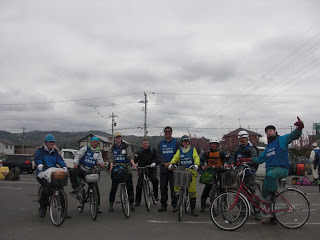 ready for the rideWe joined many other teams on gutter duty...block by block removing the concrete covers to the roadside gutters, pulling debris out, and shoveling and bagging the tsunami sludge. Our first gutters were full of oily water from which we pulled dishes, tools, books, fish, shoes and plenty of glass.
ready for the rideWe joined many other teams on gutter duty...block by block removing the concrete covers to the roadside gutters, pulling debris out, and shoveling and bagging the tsunami sludge. Our first gutters were full of oily water from which we pulled dishes, tools, books, fish, shoes and plenty of glass.
 starting in on the gutters
starting in on the gutters
 literally in the guttersThe sludge was heavy, the work filthy. Lunch break was much needed.
literally in the guttersThe sludge was heavy, the work filthy. Lunch break was much needed.
 In the neighborhood was the fruit shop that had opened several weeks earlier thanks to volunteer efforts. One of our team members bought strawberries there for us to share...fresh fruit!
In the neighborhood was the fruit shop that had opened several weeks earlier thanks to volunteer efforts. One of our team members bought strawberries there for us to share...fresh fruit!
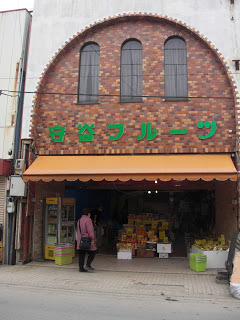 fruit shopThese were amazing paintings at the "Delicacy Shop."
fruit shopThese were amazing paintings at the "Delicacy Shop."
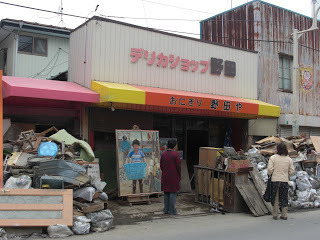 deliThen it was back to gutter work on the opposite side of the road.
deliThen it was back to gutter work on the opposite side of the road.
 More gutter work...but look how clean the right side is nowWe moved on to other blocks, first in front of a hospital, then closer to the river. At that point, teams seemed to be getting in each other's way a bit, but the good news was that by the end of that week some 90 percent of the gutters in the city center (that weren't covered by mountains of debris) had been cleaned out by volunteers.
More gutter work...but look how clean the right side is nowWe moved on to other blocks, first in front of a hospital, then closer to the river. At that point, teams seemed to be getting in each other's way a bit, but the good news was that by the end of that week some 90 percent of the gutters in the city center (that weren't covered by mountains of debris) had been cleaned out by volunteers.
These magic yellow balls were everywhere. I thought they had something to do with cleaning, and I finally asked a construction worker who explained that they were used to hold the shape of a hole they were digging when it was constantly flooding with water.
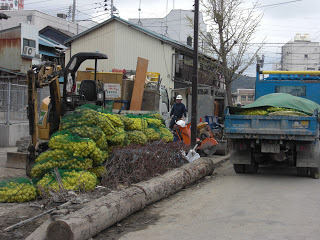 um...plastic yellow ballsAt the end of the day we took ourselves and our tools to the clean station for the last time then returned to Ai Plaza. At Ai Plaza the fire in the hearth and hot coffees awaited us, and we wrote messages on a large sheet to give to the people of Ishinomaki.
um...plastic yellow ballsAt the end of the day we took ourselves and our tools to the clean station for the last time then returned to Ai Plaza. At Ai Plaza the fire in the hearth and hot coffees awaited us, and we wrote messages on a large sheet to give to the people of Ishinomaki.
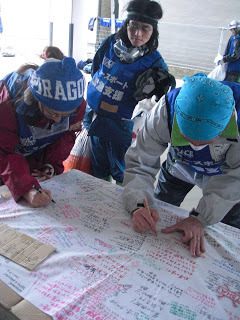 writing messages of hope and encouragement
writing messages of hope and encouragement
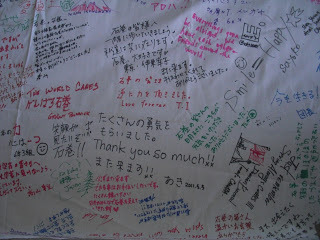 heartfelt wordsAfter a day of gutter work, it was such a pleasure to get on our bicycles again for the ride back to the university--along paths cleared through debris, then over the river and rice fields and past vegetable gardens edged with blooming yellow rape.
heartfelt wordsAfter a day of gutter work, it was such a pleasure to get on our bicycles again for the ride back to the university--along paths cleared through debris, then over the river and rice fields and past vegetable gardens edged with blooming yellow rape.
We wasted no time in getting in line for a shower. This time it was only a five-minute wait, which included a bonus small earthquake, and it was another perfect, way-hot shower.
In the evening, we put our belongings in order and donated any food and water we wouldn't use to Peace Boat volunteers who opted to stay for a second week. Then we sat around our cook stoves, ate noodles, drank tea, and shared chocolates and stories. There were plenty of laughs mixed in with the more somber reflections on our week in Ishinomaki, soon to come to a close.
There was another rumble in the middle of the night--I noted it and went promptly back to sleep. Fog and clouds had rolled in overnight and were slow to lift from the hills. At the morning meeting after our exercises, three volunteers, two of them New Zealanders, performed a haka...to give us courage to do battle against the tsunami damage.
Our team was assigned to ride bicycles into town. We'd been waiting for our turn day after day, so this was welcomed news. It was so nice be in the open air as we crossed the bridge that spanned the river and rice fields with the hills in the distance in all shades of new green. After crossing the river as we approached the center of the city it was a matter of weaving in and out debris.
 ready for the rideWe joined many other teams on gutter duty...block by block removing the concrete covers to the roadside gutters, pulling debris out, and shoveling and bagging the tsunami sludge. Our first gutters were full of oily water from which we pulled dishes, tools, books, fish, shoes and plenty of glass.
ready for the rideWe joined many other teams on gutter duty...block by block removing the concrete covers to the roadside gutters, pulling debris out, and shoveling and bagging the tsunami sludge. Our first gutters were full of oily water from which we pulled dishes, tools, books, fish, shoes and plenty of glass. starting in on the gutters
starting in on the gutters
 literally in the guttersThe sludge was heavy, the work filthy. Lunch break was much needed.
literally in the guttersThe sludge was heavy, the work filthy. Lunch break was much needed. In the neighborhood was the fruit shop that had opened several weeks earlier thanks to volunteer efforts. One of our team members bought strawberries there for us to share...fresh fruit!
In the neighborhood was the fruit shop that had opened several weeks earlier thanks to volunteer efforts. One of our team members bought strawberries there for us to share...fresh fruit!  fruit shopThese were amazing paintings at the "Delicacy Shop."
fruit shopThese were amazing paintings at the "Delicacy Shop."  deliThen it was back to gutter work on the opposite side of the road.
deliThen it was back to gutter work on the opposite side of the road.  More gutter work...but look how clean the right side is nowWe moved on to other blocks, first in front of a hospital, then closer to the river. At that point, teams seemed to be getting in each other's way a bit, but the good news was that by the end of that week some 90 percent of the gutters in the city center (that weren't covered by mountains of debris) had been cleaned out by volunteers.
More gutter work...but look how clean the right side is nowWe moved on to other blocks, first in front of a hospital, then closer to the river. At that point, teams seemed to be getting in each other's way a bit, but the good news was that by the end of that week some 90 percent of the gutters in the city center (that weren't covered by mountains of debris) had been cleaned out by volunteers.These magic yellow balls were everywhere. I thought they had something to do with cleaning, and I finally asked a construction worker who explained that they were used to hold the shape of a hole they were digging when it was constantly flooding with water.
 um...plastic yellow ballsAt the end of the day we took ourselves and our tools to the clean station for the last time then returned to Ai Plaza. At Ai Plaza the fire in the hearth and hot coffees awaited us, and we wrote messages on a large sheet to give to the people of Ishinomaki.
um...plastic yellow ballsAt the end of the day we took ourselves and our tools to the clean station for the last time then returned to Ai Plaza. At Ai Plaza the fire in the hearth and hot coffees awaited us, and we wrote messages on a large sheet to give to the people of Ishinomaki. writing messages of hope and encouragement
writing messages of hope and encouragement
 heartfelt wordsAfter a day of gutter work, it was such a pleasure to get on our bicycles again for the ride back to the university--along paths cleared through debris, then over the river and rice fields and past vegetable gardens edged with blooming yellow rape.
heartfelt wordsAfter a day of gutter work, it was such a pleasure to get on our bicycles again for the ride back to the university--along paths cleared through debris, then over the river and rice fields and past vegetable gardens edged with blooming yellow rape.We wasted no time in getting in line for a shower. This time it was only a five-minute wait, which included a bonus small earthquake, and it was another perfect, way-hot shower.
In the evening, we put our belongings in order and donated any food and water we wouldn't use to Peace Boat volunteers who opted to stay for a second week. Then we sat around our cook stoves, ate noodles, drank tea, and shared chocolates and stories. There were plenty of laughs mixed in with the more somber reflections on our week in Ishinomaki, soon to come to a close.
Published on May 15, 2011 07:50
May 13, 2011
Ishinomaki Day 6
Following is Day 6 of my week in Tohoku volunteering with the NGO Peace Boat in the tsunami-devastated city of Ishinomaki, Miyagi Prefecture.
We woke to a beautiful morning at Ishinomaki Senshu University.
 tents by the university trackThe Nasu Shiobara Onsen Association again had prepared food for us--breakfast of zosui (rice porridge) or noodles plus rice, pickled vegetables, weiners and more.
tents by the university trackThe Nasu Shiobara Onsen Association again had prepared food for us--breakfast of zosui (rice porridge) or noodles plus rice, pickled vegetables, weiners and more.
 the meal tent with menu
the meal tent with menu
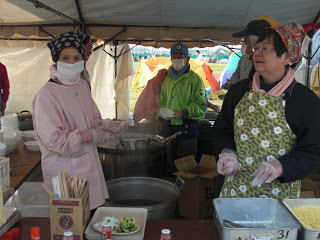 Nasu Shiobara Onsen volunteers serving us volunteers
Nasu Shiobara Onsen volunteers serving us volunteers
 breakfast in the parking lotInstead of the rajio taiso exercises at morning meeting, an international volunteer led a rendition of Wibble Your Wobbles Away. Then by 8:15 we were on a bus to the Peace Boat base of Ai Plaza. Our assignment was to help with the final cleaning of a soba shop near the train station in the center of the city. The shop was brand new and had been in operation for less than a year.
breakfast in the parking lotInstead of the rajio taiso exercises at morning meeting, an international volunteer led a rendition of Wibble Your Wobbles Away. Then by 8:15 we were on a bus to the Peace Boat base of Ai Plaza. Our assignment was to help with the final cleaning of a soba shop near the train station in the center of the city. The shop was brand new and had been in operation for less than a year.
 soba shopPrevious teams of volunteers had already removed the major sludge, so we scraped and scrubbed the floors and appliances and washed salt water marks from the walls.
soba shopPrevious teams of volunteers had already removed the major sludge, so we scraped and scrubbed the floors and appliances and washed salt water marks from the walls.
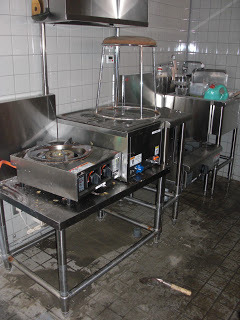 the kitchen as we started work
the kitchen as we started work
 progress with the floorCompared to our previous days of fish duty and oily sludge shoveling this was easy work. Yet when the shop owner saw one of our team members coated in dirt from lying on the floor to clean beneath kitchen racks and appliances, she broke down, overwhelmed, so grateful to us, to Peace Boat, for giving her hope, for being there with her. We all teared up, and as I held her shoulder did my best to utter words of comfort, that one step at a time, one hour and one day at a time, we could make progress. Her home, now unlivable, was in Ibarazu, where we'd picked up rotting fish. She was hoping to get the shop up and running soon.
progress with the floorCompared to our previous days of fish duty and oily sludge shoveling this was easy work. Yet when the shop owner saw one of our team members coated in dirt from lying on the floor to clean beneath kitchen racks and appliances, she broke down, overwhelmed, so grateful to us, to Peace Boat, for giving her hope, for being there with her. We all teared up, and as I held her shoulder did my best to utter words of comfort, that one step at a time, one hour and one day at a time, we could make progress. Her home, now unlivable, was in Ibarazu, where we'd picked up rotting fish. She was hoping to get the shop up and running soon.
We walked back to Ai Plaza at lunch time. It was encouraging to see a few shops cleaned up and open for business again--shoe shops, clothing shops, a bread shop.
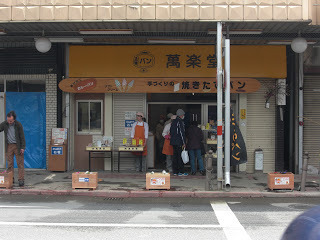 bread shop back in businessAnd at Ai Plaza carp kites were flying for Children's Day, and Peace Boat volunteers had free books and toys set out for children.
bread shop back in businessAnd at Ai Plaza carp kites were flying for Children's Day, and Peace Boat volunteers had free books and toys set out for children.
 koinobori carp kites
koinobori carp kites
 books and toys for childrenOur team ate lunch quickly, then borrowed Peace Boat bicycles and set off through town. We rode across the river into an area of extensive damage. The sights were numbing.
books and toys for childrenOur team ate lunch quickly, then borrowed Peace Boat bicycles and set off through town. We rode across the river into an area of extensive damage. The sights were numbing.


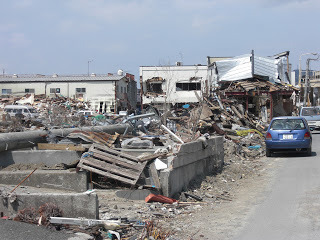
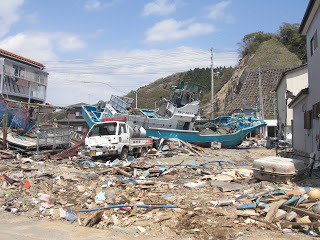
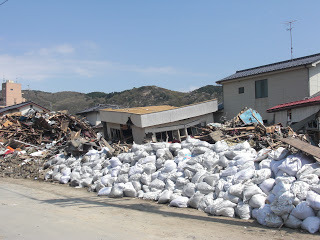
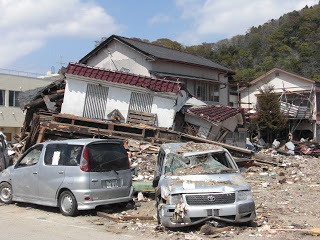
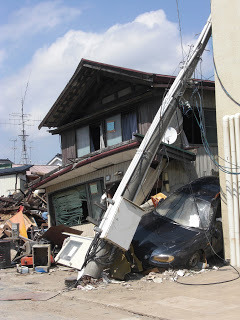

After lunch we continued our work at the soba shop. The shop owner was thrilled with the results.
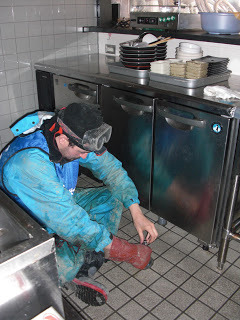 final touches in the kitchen
final touches in the kitchen
 shop owner on her now clean floor
shop owner on her now clean floor
 water marks removedWe promised to return to Ishinomaki and visit her shop when it was back in business. She, in turn, promised us buckets full of soba.
water marks removedWe promised to return to Ishinomaki and visit her shop when it was back in business. She, in turn, promised us buckets full of soba.
When we returned to camp, we decided to take advantage of hot showers we'd heard about. Just outside the university campus, Mr. Wada, who'd served communities in Kobe after the Great Hanshin earthquake in 1995 and who had come all the way from Hiroshima, had set up kerosene-heated showers that he had engineered and built. There were five stalls with changing rooms, HOT water...and it was all free. I waited forty minutes in line and in the little waiting area he'd created then had a blissful shower.
Our team cooked noodles with curry for dinner, and the night turned cold fast. By 9:30 the fellow in the tent behind mine was already snoring.
We woke to a beautiful morning at Ishinomaki Senshu University.
 tents by the university trackThe Nasu Shiobara Onsen Association again had prepared food for us--breakfast of zosui (rice porridge) or noodles plus rice, pickled vegetables, weiners and more.
tents by the university trackThe Nasu Shiobara Onsen Association again had prepared food for us--breakfast of zosui (rice porridge) or noodles plus rice, pickled vegetables, weiners and more. the meal tent with menu
the meal tent with menu
 Nasu Shiobara Onsen volunteers serving us volunteers
Nasu Shiobara Onsen volunteers serving us volunteers
 breakfast in the parking lotInstead of the rajio taiso exercises at morning meeting, an international volunteer led a rendition of Wibble Your Wobbles Away. Then by 8:15 we were on a bus to the Peace Boat base of Ai Plaza. Our assignment was to help with the final cleaning of a soba shop near the train station in the center of the city. The shop was brand new and had been in operation for less than a year.
breakfast in the parking lotInstead of the rajio taiso exercises at morning meeting, an international volunteer led a rendition of Wibble Your Wobbles Away. Then by 8:15 we were on a bus to the Peace Boat base of Ai Plaza. Our assignment was to help with the final cleaning of a soba shop near the train station in the center of the city. The shop was brand new and had been in operation for less than a year. soba shopPrevious teams of volunteers had already removed the major sludge, so we scraped and scrubbed the floors and appliances and washed salt water marks from the walls.
soba shopPrevious teams of volunteers had already removed the major sludge, so we scraped and scrubbed the floors and appliances and washed salt water marks from the walls. the kitchen as we started work
the kitchen as we started work
 progress with the floorCompared to our previous days of fish duty and oily sludge shoveling this was easy work. Yet when the shop owner saw one of our team members coated in dirt from lying on the floor to clean beneath kitchen racks and appliances, she broke down, overwhelmed, so grateful to us, to Peace Boat, for giving her hope, for being there with her. We all teared up, and as I held her shoulder did my best to utter words of comfort, that one step at a time, one hour and one day at a time, we could make progress. Her home, now unlivable, was in Ibarazu, where we'd picked up rotting fish. She was hoping to get the shop up and running soon.
progress with the floorCompared to our previous days of fish duty and oily sludge shoveling this was easy work. Yet when the shop owner saw one of our team members coated in dirt from lying on the floor to clean beneath kitchen racks and appliances, she broke down, overwhelmed, so grateful to us, to Peace Boat, for giving her hope, for being there with her. We all teared up, and as I held her shoulder did my best to utter words of comfort, that one step at a time, one hour and one day at a time, we could make progress. Her home, now unlivable, was in Ibarazu, where we'd picked up rotting fish. She was hoping to get the shop up and running soon.We walked back to Ai Plaza at lunch time. It was encouraging to see a few shops cleaned up and open for business again--shoe shops, clothing shops, a bread shop.
 bread shop back in businessAnd at Ai Plaza carp kites were flying for Children's Day, and Peace Boat volunteers had free books and toys set out for children.
bread shop back in businessAnd at Ai Plaza carp kites were flying for Children's Day, and Peace Boat volunteers had free books and toys set out for children.  koinobori carp kites
koinobori carp kites
 books and toys for childrenOur team ate lunch quickly, then borrowed Peace Boat bicycles and set off through town. We rode across the river into an area of extensive damage. The sights were numbing.
books and toys for childrenOur team ate lunch quickly, then borrowed Peace Boat bicycles and set off through town. We rode across the river into an area of extensive damage. The sights were numbing.







After lunch we continued our work at the soba shop. The shop owner was thrilled with the results.
 final touches in the kitchen
final touches in the kitchen shop owner on her now clean floor
shop owner on her now clean floor
 water marks removedWe promised to return to Ishinomaki and visit her shop when it was back in business. She, in turn, promised us buckets full of soba.
water marks removedWe promised to return to Ishinomaki and visit her shop when it was back in business. She, in turn, promised us buckets full of soba.When we returned to camp, we decided to take advantage of hot showers we'd heard about. Just outside the university campus, Mr. Wada, who'd served communities in Kobe after the Great Hanshin earthquake in 1995 and who had come all the way from Hiroshima, had set up kerosene-heated showers that he had engineered and built. There were five stalls with changing rooms, HOT water...and it was all free. I waited forty minutes in line and in the little waiting area he'd created then had a blissful shower.
Our team cooked noodles with curry for dinner, and the night turned cold fast. By 9:30 the fellow in the tent behind mine was already snoring.
Published on May 13, 2011 23:04



